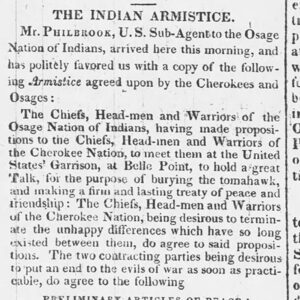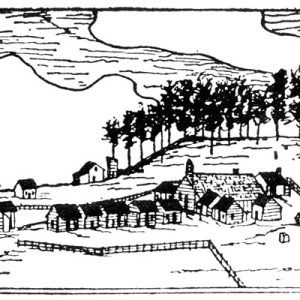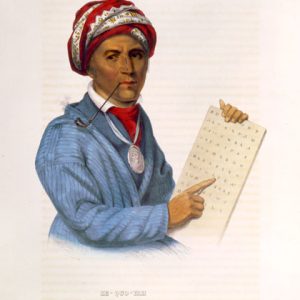calsfoundation@cals.org
Cherokee
The Europeans named the Cherokee as one of the Five Civilized Tribes. (The other four were the Chickasaw, Choctaw, Creek, and Seminole.) At the time of European contact, the Cherokee inhabited a region consisting of what is now western North Carolina and parts of Virginia, Georgia, and eastern Tennessee. Over the next two centuries, the tribe expanded through the southern Appalachians, reaching further into Georgia as well as into South Carolina, northeastern Alabama, and across the Cumberland River into Kentucky and West Virginia; some of this expansion occurred following the displacement of other tribes. By the 1780s, Cherokee migration into Arkansas had begun, largely in response to pressure to move away from Euro-American settlements in the East following the Revolutionary War.
Migration during the Settlement and Early Statehood Era
Cherokee migrated from their homeland to what became Arkansas from the 1780s to the 1820s. Their home territory in Georgia, eastern Tennessee, and western North and South Carolina had been threatened by the expansion of Euro-American settlement, and the Cherokee had lost numerous military and judicial battles with the newcomers. Cherokee had been exploring west of the Mississippi, and as many as a thousand reacted to the setbacks in their home territory by moving west into Spanish Louisiana out of the reach of the English colonies. The first Cherokee focus in Arkansas was the St. Francis River drainage and Crowley’s Ridge, with place names such as Doublehead Bluff in Cross County (named after a leader) and Big and Little Telico Creeks in St. Francis County (named after a major town in the homeland) bearing their imprint. Crow Creek in Cross County was probably not named after the bird but rather after the Crowtown Cherokee settlement. The Crowtown settlement was itself named after another homeland town. Early migrants who led parties of Cherokee families to eastern Arkansas included Connetoo (also known as John Hill), Unacata (also known as White Man Killer), William “Red-Headed Will” Webber, George Duvall, and Moses Price (also known as Wohsi).
The New Madrid Earthquakes of 1811–1812 disrupted these settlements. In June of 1812, Cherokee prophet Skawuaw (also known as the Swan) in a speech at Crowtown warned of further destruction for the Cherokee unless they gave up Anglo-American ways. In response to the quakes and this prophecy, many Cherokee abandoned eastern Arkansas and moved into the Arkansas River Valley west of what is now Little Rock (Pulaski County). This area of mountains and river valleys was similar to the foothills of the Appalachians that had been their homeland. There, unfortunately, they clashed with the Osage, who claimed the area as hunting grounds, and with American settlers moving across the Mississippi River. (Fort Smith in Sebastian County was later established to keep peace between the Cherokee and Osage.) Nonetheless, many groups of families came, along with parties that continued to drift west from the homeland. Major figures included Black Fox, Dutch, Spring Frog, Toluntuskee, and Takatoka. Some also eventually moved to the Red River area, including groups under Du-wa-li (also known as the Bowl) and later under Dutch.
Back in the homeland, increasing federal and state pressure on the remaining Cherokee led to the Turkeytown Treaty of July 8, 1817, in which land in the east was exchanged for land in northwest Arkansas, north of the Arkansas River and south of the White River. The goal of the Arkansas Cherokee was to protect their holdings and thereby create a new homeland in northwest Arkansas, although many of the Eastern Cherokee saw the treaty as a betrayal. The goal of the U.S. government was that all Cherokee would give up their native land and move to Arkansas. As many as 4000 may have done this, becoming known as the Western Cherokee. Emigrants included parties of families led by the principal chief John Jolly (brother to Tolluntuskee), Dick Justice (also known as Dek-keh the Just), the Glass, Walter “Wat” Webber, John Rogers, Tom Graves, John and David Brown, and, in 1829, Sequoyah (also known as George Gist or Guest), inventor of the Cherokee syllabary. The remaining 35,000 or so Cherokee stayed in the homeland.
Because the Cherokee owned the territory together in fee simple—that is, they were given the land as a group instead of in individual parcels—rather than it being managed for them by the U.S. government, the Arkansas land was not considered a reservation. The Western Cherokee established scattered family farmsteads and farms complete with cattle and some even with African-American slaves. The dispersed families were organized in traditional “towns,” spread out along tributaries on the north side of the Arkansas River, places such as Galla Creek, Illinois Bayou, Piney Creek, Spadra Creek, Horsehead Creek, and Mulberry River (from Pope County to Franklin County respectively), as well as Dutch Creek and Spring Creek south of the river (in Yell County). Others settled in the hills and valleys farther into the Ozarks.
Cherokee Life
The Arkansas towns were held together by ties brought west from the homeland, principally kinship ties traced through females. Their centers included a council house and a stickball court. The Western Cherokee were moving toward a centralized government, with a governing council and a principal chief—this was John Jolly after 1818. Some Western Cherokee, such as Tolluntuskee, invited Protestant missionaries who founded Dwight Mission in 1820 near what is now Russellville (Pope County) so that Cherokee children could learn Anglo-American ways. Ironically, the mission was in a location firmly under the control of Takatoka, who opposed its goals.
The Cherokee built mills, cleared land for farming and pasture, and generally improved their holdings, becoming the first real agricultural and entrepreneurial pioneers in northwest Arkansas. In what would become Pope County, for example, Sequoyah established a salt works on the north fork of the Illinois Bayou, and the Glass did the same on Hackers Creek.
The British naturalist Thomas Nuttall described the Arkansas Cherokee well in 1819 on his travels up the Arkansas River: “Both banks of the river, as we proceeded, were lined with the houses and farms of the Cherokees, and though their dress was a mixture of indigenous and European taste, yet in their houses, which are decently furnished, and in the farms, which were well fenced and stocked with cattle… argue a propitius [sic] progress in their population. Their superior industry, either as hunters or farmers, proves the value of property among them.” Nuttall’s description of leader John Jolly is particularly telling. Nuttall met Jolly and his wife at Walter Webber’s store at the mouth of Illinois Bayou on April 9, 1819. Reported Nuttall, “I should scarcely have distinguished him from an American, except by his language. He was very plain, prudent, and unassuming in his dress and manners; a Franklin amongst his countrymen, and affectionately called the beloved father.” Jolly and his thousands of Cherokee neighbors were frontiers people, but they also strove to maintain their identity as Native Americans.
Indian Removal and the Civil War Era
Pressure on the Western Cherokee by the federal government and the new Arkansas Territory eventually led to the Treaty of Washington on May 6, 1828, which ceded the Arkansas lands to the United States. Most of the Western Cherokee moved to Indian Territory in northeast Oklahoma, leaving houses, farms, orchards, and mills to be occupied by the Anglo-Americans who came to the area. These Western Cherokee became known as the Old Settlers when they were officially reunited with the main group of Cherokee following Indian Removal a few years later.
As many as 30,000 Cherokee passed through Arkansas on their way to Indian Territory in Oklahoma by land or water or a combination of the two between 1834 and 1839 as part of Indian Removal. The Trail of Tears left hundreds of dead buried in shallow graves and weakened others so that they died at the end of the journey. Some Arkansans noted the groups with sorrow, and at least one, Dr. J. C. Roberts, died while tending Cherokee cholera victims at Cadron (Faulkner County). However, Indian Removal also offered many Arkansans a chance to sell food to support the Indians and their animals en route, as well as a chance to profit from providing passage on steamboats on the rivers, wagons when the rivers were too low, and ferries across the many streams for those traveling over land.
The Cherokee Nation persisted in Indian Territory on the western border of Arkansas but not altogether peacefully. For example, factional conflicts among the Cherokee that arose during the final dissolution of the homeland in the 1830s led to civil war that lasted until 1846, though war effectively broke out again as part of the U.S. Civil War, with Cherokee fighting in both Union and Confederate forces in Indian Territory and sometimes in Arkansas. This violence led to disruptions, lawlessness, and refugees moving back and forth across the border, with some remaining in Arkansas. In more peaceful times, Indian Territory provided a market for agricultural produce and manufactured goods, allowing profit to be made by Anglo-American farmers, traders, and shippers. In hard times, Cherokee families sometimes moved into Arkansas looking for work.
Modern-day Perceptions of the Cherokee
The concept of Cherokee is a powerful popular perception in Arkansas as a result of two centuries of Cherokee presence in the state or in neighboring Oklahoma. Because of familiarity with this one group, for example, the importance of historical native peoples of Arkansas such as the Quapaw and the Caddo is often minimized, and the 10,000 years of prehistoric Indian life and resulting artifacts are sometimes erroneously thought to be products of the Cherokee. Many Arkansans trace their Indian heritage to a Cherokee grandmother or great-grandmother who was a “princess,” a claim that may or may not be true (there was no such position as princess until powwows began in the mid-twentieth century) but certainly stems from the time when Cherokee women held great influence. Some individuals and groups proclaim Cherokee ancestry but are not officially recognized by the Bureau of Indian Affairs of the U.S. Department of the Interior. Only three groups are official: the Cherokee Nation of Oklahoma, the United Keetowah Band of Cherokee Indians, and the Eastern Band of Cherokee Indians.
The adaptations made by the Cherokee to American society, the mobility of Cherokee individuals and small groups throughout the centuries, the resistance of many to government intrusion, and the prejudice that dominated the Anglo-American view of Native Americans until the last couple of decades all introduced ambiguities into the question of who might or might not be Indian. But when people in Arkansas celebrate their Indian heritage (even though they might dress in Plains Indian styles), they generally associate themselves with the Cherokee.
For additional information:
Bauer, Frankie. “Civilized Settlement and Nomadic Dominion: Inter-Tribal Treaties and Grand Councils between the Cherokee and Osage Indians, 1817–1828.” MA thesis, Western Carolina University, 2018.
Cherokee Archival Project. http://www.rootsweb.com/~cherokee/ (accessed July 11, 2023).
Cherokee Nation. http://www.cherokee.org/ (accessed July 11, 2023).
Davis, Hester A. “The Cherokee in Arkansas: An Invisible Archeological Resource.” In Visions and Revisions: Ethnohistoric Perspectives on Southern Cultures, edited by George Sabo III and William Schneider. Southern Anthropological Society Proceedings 20. Athens: University of Georgia Press, 1987.
DeBlack, Tom. “The War within the War: The Cherokees and the Civil War in Arkansas.” Pope County Historical Quarterly 46 (September 2012): 6–14.
Dickens, Roy S. “The Origins and Development of Cherokee Culture.” In The Cherokee Nation, edited by Duane H. King. Knoxville: University of Tennessee Press, 1979.
Everett, Diana. The Texas Cherokees: A People between Two Fires, 1819–1840. Norman: University of Oklahoma Press, 1990.
Foreman, Grant. Indian Removal: The Emigration of the Five Civilized Tribes. Norman: University of Oklahoma Press, 1974.
Harmon, Michael Anthony. Eighteenth Century Lower Cherokee Adaptation and Use of Material Culture. Volumes in Historical Archaeology. Columbia: The South Carolina Institute of Archaeology and Anthropology, 1986.
Key, Joseph Patrick. “Indians and Ecological Conflict in Territorial Arkansas.” Arkansas Historical Quarterly 59 (Summer 2000): 127–146.
Lankford, George. “The Cherokee Sojourn in North Arkansas.” Independence County Chronicle 18 (January 1977): 2–18.
Myers, Robert A. “Cherokee Pioneers in Arkansas: The St. Francis Years, 1785-1813.” Arkansas Historical Quarterly 56 (Summer 1997): 127–157.
Stewart-Abernathy, Leslie C. “Some Archeological Perspectives on the Arkansas Cherokee.” Arkansas Archeologist 37 (1996): 39–54.
Turrentine, G. R. “Dwight Mission.” Arkansas Valley Historical Papers 25 (April 1962): 1–11.
Vance, David L. Early History of Pope County. Mabelvale, AR: Foreman Payne Publishers, 1970.
Visit Cherokee Nation. https://visitcherokeenation.com/ (accessed July 11, 2023).
Washburn, Cephas. Reminiscences of the Indians. Conway, AR: Oldbuck Press, 1993.
West, Cane. “Environmental Negotiators: Cherokee Power in the Arkansas Valley, 1812–1828.” MA thesis, University of South Carolina, 2017. Online at https://scholarcommons.sc.edu/etd/4125/ (accessed July 11, 2023).
———. “‘They Have Exercised Every Art’: Ecological Rhetoric, a War of Maps, and Cherokee Sovereignty in the Arkansas Valley, 1812–1828.” Journal of the Early Republic 40 (Summer 2020): 297–327.
Leslie Stewart-Abernathy
Arkansas Archeological Survey, Russellville
 Armistice Story
Armistice Story  Duwali
Duwali  Dwight Mission
Dwight Mission  Sequoyah
Sequoyah 




Many years ago, I found a relative on the 1835 Indian Removal document. He was born in Cherokee County, Alabama, ca. 1832. That would make him a child during the Trail of Tears. Next we find him in Hot Springs, Arkansas. He had two wives, and most of all the children survived. He survived too. The census finds his daughter Adeline Bell married to Bradly Woods; I heard they met on a wagon train. They farmed around Hot Springs until they moved to Eastland, Texas, where they homesteaded a large plot of land. There were stories of Adeline going to Oklahoma at times to serve as a midwife to other families. My grandmother served as a midwife in Texas. There is hidden history in our family. No one spoke to openly about the tribe. They seemed to wish peaceful co-existence. I know that my immediate group never landed in Oklahoma. I realize they must have had extended family there. Names of Cherokee were hard to follow, especially the females. I don’t know if anyone could find the possible names of my great-grandmothers. There would be no formal marriage records. It is sad that so much culture and history is lost. We would have large family reunions. Children were highly valued and we played freely. We laughed and told stories. I look back and feel frustration about not knowing more about the true heritage. The commitment to extended family was amazing. I don’t find that support system these days. Surnames would be Bell, Campbell, Woods, and Fox. I have searched for Emsley Woods everywhere. He dies in Hot Springs shortly after or during the Civil War. He never shows up on immigration records, only an Arkansas census. He dropped into Arkansas from who knows where.
As a child, I remember my uncles, brothers of my grandmother, Lina Woods, going to powwows and not paying, around 1930. They seemed to straighten their posture and just walk right through. I now realize that they were Native American and they knew it (white or non-Indians paid two dollars). I said this to my mother, who was told she is dark Dutch, and she looked puzzled, saying, oh, I just think my uncles had good tans they were excellent farmers. I dont think that is it at all. I remember some other cultural stuff in my family from Arkansas and Texas. Quite normal for them, but non-white. They honored women and their insights. Only the men seined the river for trout. They were feeding about thirty family members. They had a profound respect for nature and leaving it unadulterated. The women enjoyed each other, sewing around a fire at night. That is where most of the needlework was done. My grandmother loved needlepoint and embroidery. No, they were not using beads. The food might be a bit different for holiday gatherings. Of course, we had turkey, and young black-eyed peas were a treasure. Those were in the pod still. Cornbread and beans were a staple. I just remember so many things coming from my uncles gardens that I miss now and would be hard-pressed to find. Because women are naturally tied to the mother earth energy, men are connected by water and other types of purification. Going fishing while in the water and as a group using the net is one of those acts. On hunting trips, they would also purify in different ways. They never once said that these customs are Cherokee. I just realize it now. I felt very loved and appreciated among this side of the family.
I was born in Perryville, Arkansas, in the 1940s. My mother was from what was then termed “The South Fourche” area in Yell County, close to Plainview. From what I was told by my mother (who was a Nooner), my great-grandmother Mrs. Margaret Nooner was a Cherokee. She hailed from a Cherokee settlement in that region that was in southern Yell County and apparently northern Garland County.
From what I was told by other members of my mother’s family, there was a settlement of Cherokee in that area that had been there for some time. Just what their connection to the other Cherokee was I cannot say, but there are others in that area, or were, who had lived there for quite some time.
One such family name from that region is Hawk, and another is Ott. My brother did research and found that my mother’s mother was one-half Cherokee also.